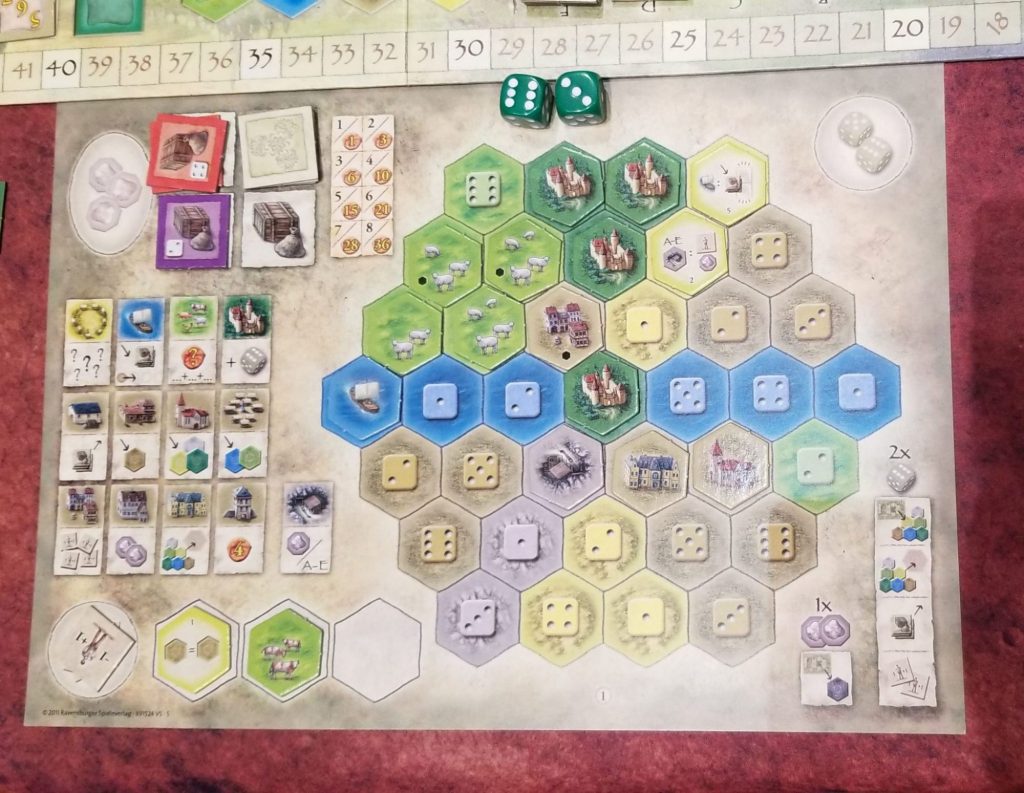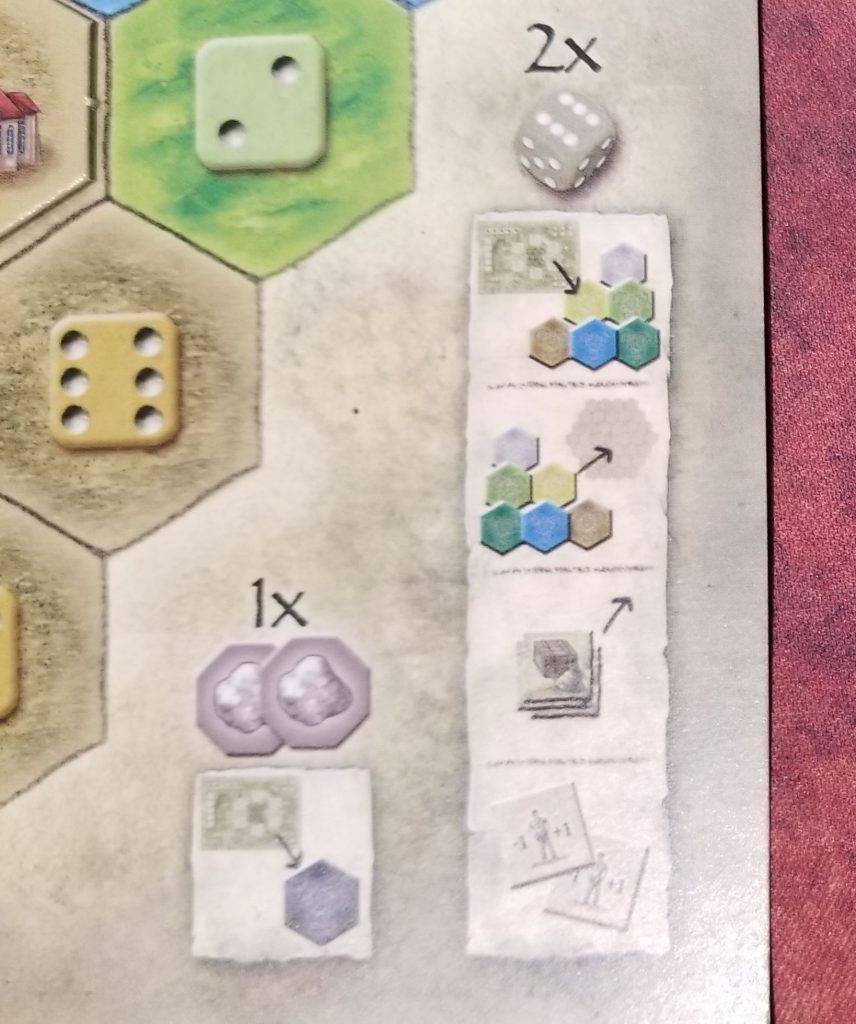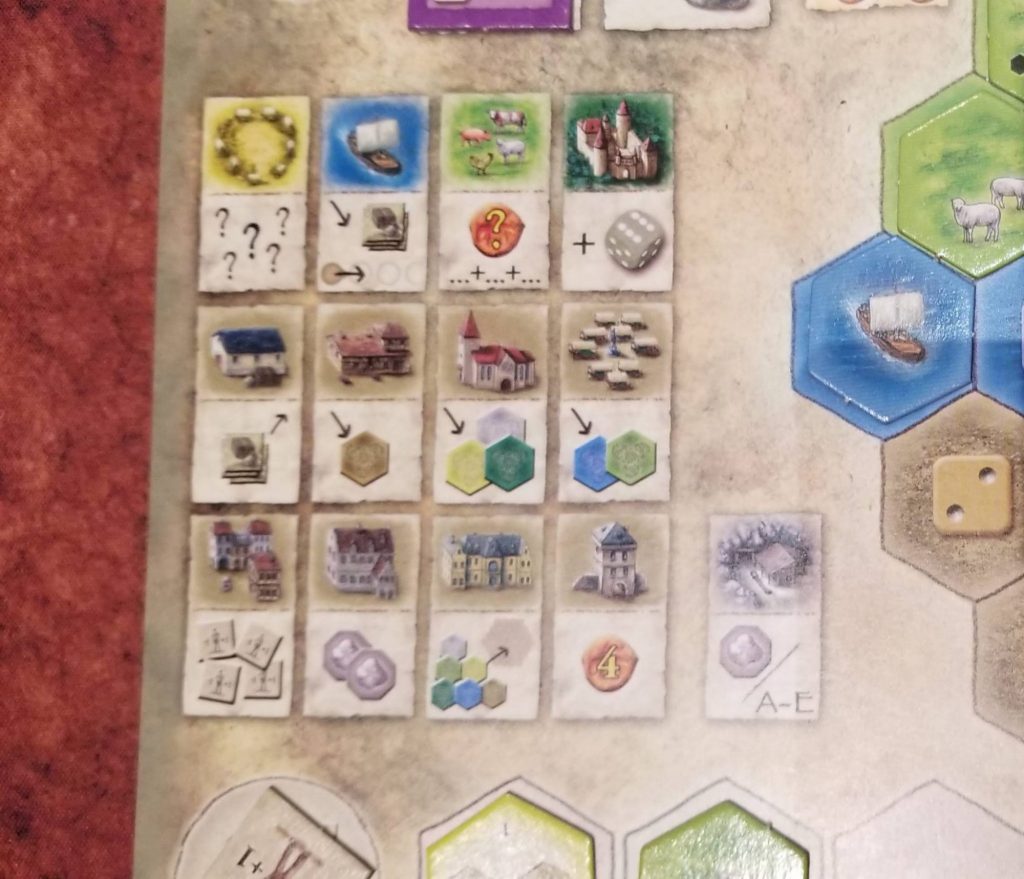Hello and welcome to ‘Focused on Feld’. In my Focused on Feld series of reviews, I am working my way through Stefan Feld’s entire catalogue. Over the years, I have hunted down and collected every title he has ever put out. Needless to say, I’m a fan of his work. I’m such a fan, in fact, that when I noticed there were no active Stefan Feld fan groups on Facebook, I created one of my own.
Today we’re going to talk about 2011’s The Castles of Burgundy, his 13th game.
Overview
It is the 15th century in the Loire Valley region of France. The nobles, in an effort to stay one step ahead of their peers, have gone castle crazy. Large, opulent estates have sprung up everywhere you look and their beauty is unmatched. It’s a great time to be a castle builder.
In the game of The Castles of Burgundy, you will take on the role of a prince trying to marshal his resources in order to construct the biggest and the best estate that the region has ever seen. Each turn of the game will present new challenges to overcome and new opportunities to be seized. It’s going to take a lot of cunning, a lot of skill, and a little bit of luck to emerge the victor. Do you have what it takes?
If you’ve played Castles of Burgundy before or you’re only interested in finding out what I think about the game, feel free to skip ahead to the Thoughts section. For the rest of you…
Know Your Environment
The Game Board
The game is played in five phases and each of these phases are broken down into five rounds. At the beginning of the game, five random goods tiles are placed face down onto each of the phase storage locations at the top left of the board. Beneath each phase storage location is a number that dictates how many victory points players may earn during that phase by completing regions (which we will discuss when we talk about the player mats).

To the right of this and taking up most of the game board surface area, are the depots. Each depot is a large, empty square numbered 1 through 6. Each depot is surrounded by several hexagonal areas labeled with a number between 2 through 4 and colored to match the different types of tiles. The number corresponds to the number of players that are playing and the color determines which type of random, face up hexagonal tile should be placed here during the round set up.
In the upper right hand corner and lower right hand corner of the game board are storage areas for the bonus tiles. These bonus tiles are given to the first person to fill in all of the regions on their player mat of a same color and then there is a smaller bonus tile that will be awarded to the second player to do so.
In the lower left hand corner is the turn order track. Turn order shifts constantly throughout the game, with the player whose pawn is furthest to the right going first. If more than one player occupies the same space, the player whose pawn is on top of the stack goes first.

Above this track is the round storage. At the beginning of each phase, the stack of face down goods is removed from the first non-empty phase storage space that is furthest to the left and these goods tiles are placed face up into the round storage spaces. At the beginning of the round, when the starting player rolls their dice, that player will also roll a white die to determine which depot the topmost goods tile should be placed in.
In the middle of everything is an area comprised of small black hexagons. At the beginning of each new phase, any tiles remaining here are removed and will be replaced with face up, random, black backed hexagon tiles. These tiles can only be purchased with silverlings (in-game coin) which is why there is a special area for them.
The Player Mats
Beginning with the upper left hand corner each mat has a storage area for a player’s silverlings. Every player will begin the game with one silverling apiece. To the right of this is a storage area for a player’s collected goods tiles. A player can only ever have three different types of goods at a time. As such, there are only three spaces here to accommodate goods tile storage. Goods tiles of the same type are stacked one atop the other. Also included here is a fourth space where previously sold goods are placed face down. To the right of this is a region scoring bonus chart. Whenever a player fills up an entire region then they will receive a number of bonus points based upon how many spaces that region was comprised of.

In the upper right hand corner is an area for dice storage. After a player has used a die, it is placed here so that the player and the player’s opponents are aware that this die is no longer in play. In the lower right hand corner is an area containing a summary of all of the various actions available to a player on their turn. The lower left hand corner displays summaries of each of the different hexagonal tile types and what they do. There is also an area here for tile storage and worker tile storage. A player may only have 3 hexagon tiles in their storage at any given time, but there is no limit to the number of workers they can hold onto. We’ll talk more about the worker tiles a bit later.
And finally, we come to the most important part of the game… the estate. Situated right in the middle of each player mat is an estate, made up of a bunch of different colored hexagons. Each of these hexagons contains a different die face. Some of the colors are clustered together into groups. A group of same-colored hexagons is referred to as a ‘region’. So, if there is a yellow hexagon sitting off by itself, then that one single hexagon represents an entire region. And each of these different colors is the same color as the different tiles. A yellow tile goes into a yellow region, a blue tile goes into a blue region, etc.
Phases and Rounds
As I mentioned previously, the game is divided into 5 phases which are further divided into 5 rounds. At the beginning of each phase, all of the hexagon tiles that remain from the previous phase are removed from the board and a new tableau of hexagon tiles is created. Then the round begins and the players will roll their dice to determine which actions are available to them for the round and a goods tile is placed into the depot determined by the white die. Then, beginning with the starting player, each player will take two actions and then an optional bonus action.

Here are the actions that are available:
Take a tile: the player may take a tile from one of the numbered depots equal to the die face of one of their rolled dice. The player may adjust this die roll by + or – 1 by discarding one of their worker tiles.
Place a tile into the estate: the player may place one of the tiles from their tile storage into their estate and perform the associated action. The tile must be placed into a space that is the same color as the tile and whose die face matches one of the dice that was rolled. The player may adjust this die roll by + or – 1 by discarding one of their worker tiles.
Sell goods tiles: the player may sell a stack of goods tiles whose die face matches one of the dice that was rolled. The player may adjust this die roll by + or – 1 by discarding one of their worker tiles. Each sold goods tile is worth 1 victory point per the number of people playing and, regardless of how many tiles are sold, the player also collects 1 silverling.
Take 2 worker tiles: the player may take two worker tiles from the supply regardless of the number on the die face.
Purchase a black tile: In addition to their two normal actions, the player may also purchase a black tile for two silverlings. This special action can be performed at any time during the turn.
The Hexagon Tiles

There are six different kinds of hexagon tiles and I am not going to go into great detail about them, but it helps to have a general idea of what they allow you to do. So, here you go:
Blue ship: take all of the goods tiles from a single depot and then move your marker up the turn order track one space.
Green castle: perform any available action as if you had rolled that number on a die.
Brown building: perform the action of the building that is being placed. Some examples: earning 4 victory points, adding a second tile from your storage to your estate, or gaining an additional tile from any one of the numbered depots.
Grey mine: you will earn 1 silverling at the beginning of each phase for each mine in your estate.
Yellow knowledge: earn whatever bonus the tile provides at the end of the game or reap whatever benefit it provides during the course of the game. Some examples are tiles that allow you to add or remove die pips when taking tiles from the depots or adding tiles to your estate.
Green animals: earn victory points equal to the number of animals shown on the tile. If this is not the first animal tile in the region, you will also earn the points from any previous animal tiles of the same type.
Thoughts
There must be something in the water because I simply cannot get enough of this game; I’m sort of addicted to it. When I’m not playing it face-to-face with other people I’m playing five or six games of it online. It’s just that good. After having played so many sessions of this game, I understand why it has become such a classic.
The mechanics for this game are inspired. Everything here belongs and there is nothing out of place. This game runs like a fine tuned machine. Every phase… every round… every die roll presents the player with new and unique challenges and decisions, and all of these decisions have far reaching, game changing consequences.
Should you waste two or three of your workers to grab a tile that you know is in high demand or do you play it safe and do something else? Is it more cost effective to focus on filling in this one single region or is it more wise to focus on building up for the next phase? Sell now or sell later? These decisions never stop presenting themselves. Every single turn is a crossroads and the correct path to take is never clear or certain. And I think that this is what I really love about this game. With so many options and only two dice it is virtually guaranteed that no two games will ever be the same.
Then there are the visuals. While not the most popular opinion, I think this game looks stunning. The colors, while bright and vibrant, have an antiquated quality about them that gives one the feeling that they’re playing a game using a very old map or a label from a hundred year old bottle of wine. Even without the pieces laid out, the bare bones setup is a feast for the eyes. Add in all of the tiles and everything comes alive.
Also, to further ensure that future games will be unique, there are even nine different player mat layouts to choose from and each of these presents its own unique challenges, and this is where I find something to complain about. These player mats feel cheap. The cardboard that they are constructed out of is thin and flimsy. I’ve bought shirts at the department store that had cardboard inserts that were thicker. Coupled with the low quality of the player boards, the only storage solution provided for all of the various tiles is a thin plastic tray with oversized compartments and not a single plastic bag to hold any of the tiles in. So you might as well forget about storing this game on its side which, judging by the way it is labeled on the spine, is precisely the way that it was meant to be stored. So, yeah, I’m not particularly impressed by that either. The publisher has done the game a disservice in these respects because the game is pretty much perfect otherwise.
Flimsy boards and lack of bags aside, I love The Castles of Burgundy and I am pretty confident that you will too. If this game is not already a part of your board game collection, then you should rectify that promptly. You’ll be glad you did. Keep your eyes peeled for the upcoming Kickstarter for the deluxe reprint of this amazing game. Also, if you like dice with your eurogames, then you should check out Andrew Plassard’s Top 6 Euros With Dice article. There are some excellent recommendations there!












Thanks for the review.
You’re welcome. Glad I could be of assistance. =)